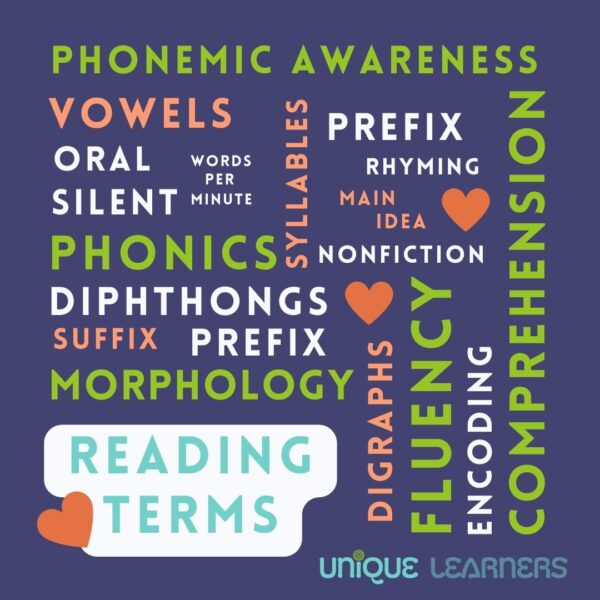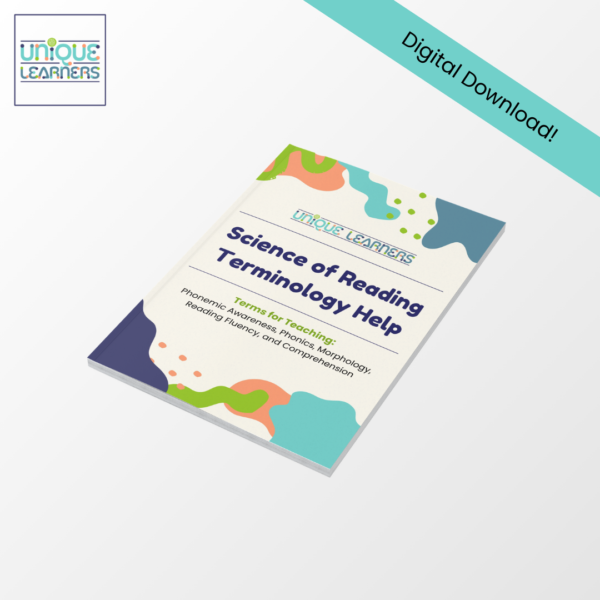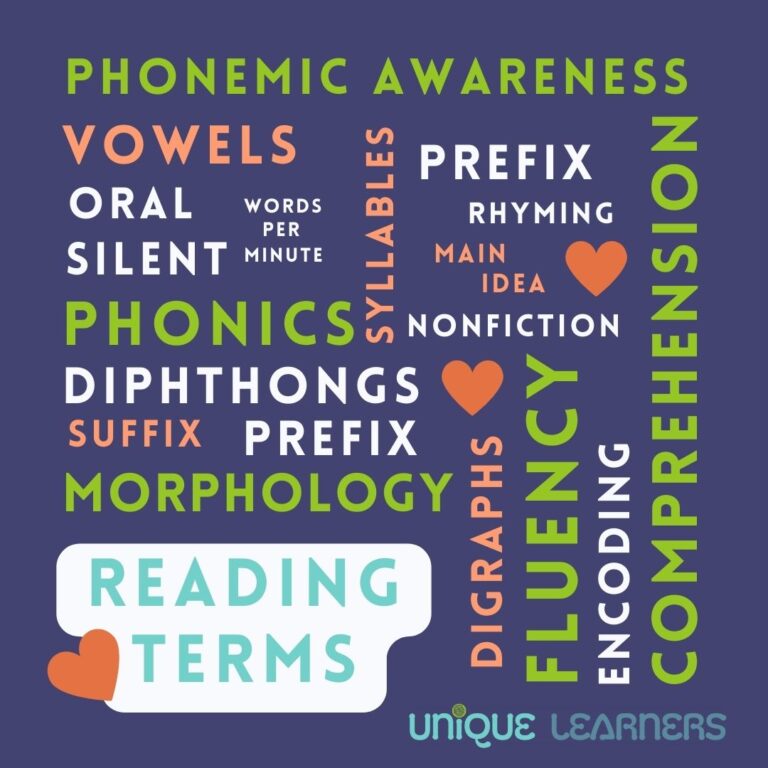Many homeschool moms choose to use a systematic phonics program to teach their children to read. Once they get the teachers manual, they encounter a lot of specific terms that may be unfamiliar. Just learning how to use the lessons may be daunting, but understanding the technical phonics terms and the meaning behind them can make presenting the lessons flow more smoothly. Of course, we will throw in a few fun suggestions for multisensory activities – because that is so important to both effective learning and to make phonics FUN!

Science of Reading
The term Science of Reading is a current term that refers to the collective of theories about the most effective ways to teach reading. The term Science of Reading is promoted by advocates of structured literacy or phonics-based reading methods. The alternative approach is Balanced Literacy that is based on theories founded in whole language.
The Science of Reading is evidence-based, meaning the approach described is based on reliable, trustworthy, and valid evidence that has demonstrated success in consistently improving students’ reading competency in the areas of phonemic awareness, phonics, reading fluency, vocabulary development, and reading comprehension.
Science of Reading is based on five important areas of teaching reading:
- Phonemic Awareness
- Systematic Phonics
- Fluency
- Vocabulary
- Comprehension
Popular phonics and reading programs on the homeschool market tend to be based on Science of Reading principles; although some of the phonics programs lack fluency and comprehension components.
We want to make the terms of the Science of Reading clear, so that as you shop for curriculum, you compare the programs more confidently and evaluate for the needs of your children. You can download a FREE copy of our Science of Reading Terminology E-book here!

Phonemic Awareness

This is the ability to hear, identify, and manipulate individual sounds—phonemes—in spoken words. Phonemic awareness is critical for learning to read and is the foundation of phonics. The auditory training of sounds in spoken words helps students to be more aware of patterns in words, like beginning sounds, ending sounds, and rhyming words. For a list of phonemic awareness skills, download the free Science of Reading Terminology ebook here.
Articulation
Articulation is speaking in clear and distinct sounds. Speaking sounds properly is essential for others to understand what a person is saying, but it is also important for matching sounds to letter symbols. If your child has difficulty with producing clear speech, you may want to seek out a speech-language therapist to work on articulation with your child.
Phonics

Phonics refers to teaching students how to match individual sounds (phonemes) to letters or letter groups to read (decode) and spell words (encode). Phonics teaches reading based on the structure of the English language by using the building blocks to sound out words.
Alphabetic Principle
The alphabetic principle is connecting letter symbols with their spoken sounds to read and spell.
Consonant Blends
A consonant blend is when two consonants come together where both sounds are heard, yet flow together. Most consonant blends fall under the categories of l blends, r, blends, s blends, and triple blends. (Examples: bl, fl, cr, gr, sm, sp, scr, spl).
Consonant Digraphs
A consonant digraph happens when two written consonants represent one sound. (Examples: ch, sh, ph, th, wh).
Decodable Text
Decodable Text that is passages or stories written using words that contain phonics words that students have been taught. Although a few sight words or high frequency words may be used, the text will contain only words that have already been taught, and the emphasis will be on the phonics words.
Decoding
Decoding is the process of translating printed words into sounds. Written words are considered a code for spoken words. Effective decoding is a key skill because it enables individuals to recognize familiar words quickly and to figure out words they haven’t seen before. When students decode a word, they translate how a word is spelled into the individual sounds, and then blend them into the represented word.
Diphthong
A Diphthong is when two vowels blend together and a slide or slight sound shift occurs during the production of the syllable. (Examples: au, aw, eu, ew, ou, ow).
Encoding
Encoding is when students translate a spoken word into a written word using the sounds and phonics rules to record the word. Encoding is actually just spelling. Encoding is a very important aspect of a child progressing in decoding and reading fluently.
“Fizzle” or “Floss” Rule
The Fizzle or Floss Rule is used when there is one syllable, a short vowel, and the ending sound is: /f/, /l/ /s/ or /z/. The ending letter is usually doubled, but only for one-syllable words.
Long vowel
A vowel that is spoken with tension in the vocal cords with relatively longer duration than short vowels. We sometimes tell students that long vowels say their names. Long vowels are marked with a little straight line.
Segmenting and Blending
Segmenting is the process of separating a word into smaller units, such as individual phonemes, syllables, or affixes. Blending is the process of combining phonemes smoothly to create words.
Short Vowel
A vowel that usually occurs in a closed syllable and is marked with a breve or a little smile.
Fluency

Reading fluency is the ability to read text quickly, accurately, and with proper expression. Fluent readers recognize words and comprehend them simultaneously, which allows for smooth and efficient reading.
Oral Reading Fluency
Oral Reading Fluency can be improved when a reader has covered many phonics rules and can read aloud with an adequate rate (at least 35 words per minute), high accuracy (less than 5 errors or help decoding), and with expression. Fluency is measured in Words Per Minute (WPM) with errors subtracted from the total count of words attempted. The goal of oral reading fluency is between 100 and 150 wpm.
Silent Reading Fluency
Silent Reading Fluency can be improved when a reader has transitioned from oral reading to silent reading. Oral reading rate should be around 100 wpm with practice until a student reads 250 wpm or more. Speed readers may reach 1,000 wpm. Silent reading rate is measured by timing a student’s time reading a given passage. Effective reading is measured by comprehension questions.
Curriculum-based Measurement
Curriculum-Based Measurement is a formative assessment that is tied to reading passages from your choice of curriculum. CBM measures reading fluency progress, which has been shown in research to relate closely to improvement of all other reading skills, including comprehension.
Automaticity
Automaticity is the ability to read letters or words automatically without having to think about it. While automaticity may refer to the speed of reading a story or passage, it may also include rapid naming of letter sounds or lists of words.
Vocabulary and Morphology

In the context of reading, vocabulary refers to the repertoire of words for which one understands the meaning. A strong vocabulary supports reading comprehension because it allows readers to make sense of what they are reading. There is a difference between a student’s spoken vocabulary and reading vocabulary.
As student’s master one-syllable phonics rules, instruction in morphology takes over. Think of it as advanced phonics. Morphology involves learning how to break down or segment multiple syllable words by following the rules of the six syllable types.
Following the syllable rules, readers learn how to analyze words for prefixes, suffixes, and base words. Eventually, learning classical roots to attribute meaning to the component parts of words can help a student progress to advanced vocabulary.
Affix
A morpheme or meaningful part of a word, includes prefixes, base words, and suffixes.
Base Word
Base words are also known as root words. Base words can stand alone. They are words, usually of Anglo-Saxon origin, to which affixes can be added.
Closed Syllable
A Closed Syllable is a syllable with a short vowel followed by one or more consonants. Unaccented closed
syllables typically have the schwa vowel sound.
Silent e Syllable
A silent e syllable has an e at the end of the short word or at the end of a longer word that makes the initial vowel long most of the time. If a word has the long e sound at the end of a word or syllable, it is spelled with a y.
Structural Analysis
Structural Analysis is a reading decoding process where students look at morphemes: prefixes, base words, and suffixes. Successful readers apply both word analysis and structural analysis to decode multisyllabic words.
Word Analysis
Word Analysis is a reading decoding process that focuses on syllables and applying syllable division rules. Successful readers apply both word analysis and structural analysis to decode multisyllabic words.
Reading Comprehension

Reading comprehension is the ability to process text, understand its meaning, and integrate it with what the reader already knows. Good comprehension is critical to becoming an accomplished reader.
Narrative or Story Comprehension
Narrative text is a story that tells about an event or experience. A narrative can be fictional or a retelling of an actual experience in a person’s life. A narrative is structured around literary elements, such as setting, characters, problem, solution, and theme.
Nonfiction Comprehension
Nonfiction reading comprehension centers around specific ways that information is organized. The specific skills include: main idea, recalling facts or details, making inferences, drawing conclusions, context clues, following directions, and locating answers.
Teaching phonics and reading using the Science of Reading involves explicit instruction. Explicit instruction involves direct explanation where concepts and rules are explained and skills are
modeled and practiced using multisensory activities. The teacher’s language is concise, specific, and related to the objective, and guided p
ractice is provided. Activities involve using all forms of input modalities (Visual, Auditory, Tactile, and Kinesthetic) as simultaneously as possible.
We want you to be successful in teaching your unique learner to read and spell! That is why we created this Reading and Phonics Terminology Ebook, so that you can understanding what teaching terms that are unfamiliar in whatever phonics and reading curriculum you are using! Download your Ebook here!
By understanding these foundational concepts, educators, students, and anyone involved in the learning process can better grasp the complexities of reading and the strategies necessary for teaching and improving literacy skills.
Here are some other websites that have lists for phonics and reading terms:
- https://www.reallygreatreading.com/six-layers-phonemic-awareness
- https://www.cde.state.co.us/coloradoliteracy/sorglossaryofterms
- https://www.scsk12.org/commitment/files/2019/Foundational%20Literacy%20Glossary%20of%20Terms.pdf
- https://www.longthorpe.net/_site/data/files/users/curriculum/phonics/628BA9F7EA294DECE11B8F8DD1ABD80A.pdf

